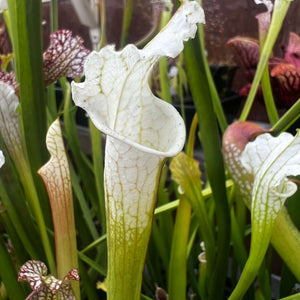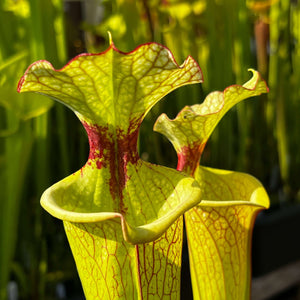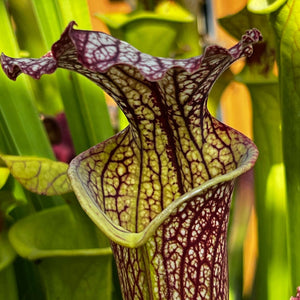Description of Iris ensata 'Variegata'
Iris ensata 'Variegata' is a Japanese Iris with a strong visual appeal. It brings two seasons of interest to damp parts of your garden. The plant is known for its foliage and its summer flowers.
Appearance and Key Features
This iris grows to a height of about 90 to 120 cm. It spreads 45 to 60 cm wide. The leaves are long and sword-shaped. They have a clear pattern of green centres and creamy-white edges. This leaf colour lasts from spring until autumn.
Flowers appear in midsummer, around June and July. Each bloom is large, often 15 to 20 cm across. The petals are flat and have a ruffled look. Colours are typically a rich purple or violet. You will see intricate veining and a small yellow mark at the centre of each flower.
Ideal Growing Conditions
Iris ensata 'Variegata' needs moist soil to thrive. It is perfect for the edge of a pond or a bog garden. It can even grow in shallow water up to 10 cm deep.
Plant it in a spot that gets full sun for most of the day. This ensures the best flower display. It can handle a little shade, especially in hotter parts of the country. The soil should be rich and on the acidic to neutral side. Mix in plenty of compost or well-rotted manure before planting.
This plant is fully hardy in the UK. It will survive winter frosts and return each year.
Planting and Ongoing Care
Keep the soil consistently moist. Water regularly during dry spells, as dry soil will affect its growth. A layer of mulch around the base each spring helps retain moisture and suppress weeds.
Feed the plant in early spring. Use a balanced, slow-release fertiliser that is not too high in nitrogen. After flowering, you can cut the old flower stems back. In late autumn, tidy up the plant by removing any dead or damaged leaves.
How to Propagate Your Iris
The best way to make new plants is by division. Every three to four years, the clump can become crowded. The best time to divide is in late summer, after it has finished flowering.
Lift the entire clump from the ground with a fork. Gently pull the rhizomes apart or cut them with a sharp knife. Replant the healthiest divisions straight away into moist soil. This process keeps the parent plant vigorous.
Garden Design Uses
This iris works well in several garden settings. Its main use is in water gardens or at the margins of wildlife ponds. The variegated leaves add light and texture to planting schemes even when the plant is not in flower.
The large flowers are also good for cutting. They can make a dramatic addition to indoor vases. The plant also helps stabilise soil on wet banks, preventing erosion.
Benefits for Wildlife
The summer flowers attract pollinators. Bees and butterflies visit the blooms to collect nectar. This makes the plant a helpful choice for supporting garden wildlife.
Iris ensata 'Variegata' is a reliable perennial for moist ground. Its foliage provides a long season of interest, and its summer flowers are a highlight. It is a practical choice for gardeners dealing with wet soil who want a plant with strong visual impact.

 UK-grown carnivorous plants
UK-grown carnivorous plants








